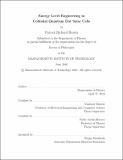| dc.contributor.advisor | Vladimir Bulović and Pablo Jarillo-Herrero. | en_US |
| dc.contributor.author | Brown, Patrick Richard | en_US |
| dc.contributor.other | Massachusetts Institute of Technology. Department of Physics. | en_US |
| dc.date.accessioned | 2016-09-30T18:24:32Z | |
| dc.date.available | 2016-09-30T18:24:32Z | |
| dc.date.copyright | 2016 | en_US |
| dc.date.issued | 2016 | en_US |
| dc.identifier.uri | http://hdl.handle.net/1721.1/104457 | |
| dc.description | Thesis: Ph. D., Massachusetts Institute of Technology, Department of Physics, 2016. | en_US |
| dc.description | This electronic version was submitted by the student author. The certified thesis is available in the Institute Archives and Special Collections. | en_US |
| dc.description | Cataloged from student-submitted PDF version of thesis. | en_US |
| dc.description | Includes bibliographical references (pages 207-235). | en_US |
| dc.description.abstract | Lead sulfide colloidal quantum dots (PbS QDs) possess a uniquely tunable set of electronic properties that has generated considerable interest in their use as active materials in lightweight, flexible, solution-processed photovoltaics. The bandgap of PbS QDs can be tuned across the entire range relevant for solar cells through modification of the QD size, and a range of other QD electronic properties can be modified through control of the chemical ligands bound to the QD surface. In this thesis we demonstrate how control of the energy level profile within PbS QD solar cells can be used to understand and improve their operation. First, we demonstrate that improvements in power conversion efficiency may be attained for ZnO / PbS QD heterojunction photovoltaics through the incorporation of a MoO3 interlayer between the PbS QD film and the top-contact anode. The deep-work-function MoO3 layer mitigates a Schottky junction that would otherwise form at the PbS / anode interface, resulting in performance improvements for devices employing a range of different anode materials. Then, we demonstrate how the tunable bandgap of PbS QDs can be used to elucidate charge- and exciton-transfer processes within hybrid organic /QD photovoltaic devices that demonstrate singlet exciton fission. We find that PbS QDs can accept electrons from triplets generated by singlet fission in pentacene and act as low-bandgap light absorbers complementary to the singlet fission material, and we explore the dependence of the triplet dissociation process on the energy levels of the QDs. Finally, we show that the energy levels of lead sulfide QDs, measured by ultraviolet photoelectron spectroscopy, shift by up to 0.9 eV between different chemical ligand treatments. The directions of these energy shifts match the results of density functional theory calculations and scale with the ligand dipole moment, and trends in the performance of photovoltaic devices employing ligand-modified QD films are consistent with the measured energy level shifts. These studies identify energy level shifts resulting from interface modification, QD bandgap modification through size control, and ligand-induced surface dipoles as means of predictably controlling the electronic properties of colloidal QD films and as versatile adjustable parameters in the performance optimization of QD optoelectronic devices. | en_US |
| dc.description.statementofresponsibility | by Patrick Richard Brown. | en_US |
| dc.format.extent | 235 pages | en_US |
| dc.language.iso | eng | en_US |
| dc.publisher | Massachusetts Institute of Technology | en_US |
| dc.rights | M.I.T. theses are protected by copyright. They may be viewed from this source for any purpose, but reproduction or distribution in any format is prohibited without written permission. See provided URL for inquiries about permission. | en_US |
| dc.rights.uri | http://dspace.mit.edu/handle/1721.1/7582 | en_US |
| dc.subject | Physics. | en_US |
| dc.title | Energy level engineering in colloidal quantum dot solar cells | en_US |
| dc.type | Thesis | en_US |
| dc.description.degree | Ph. D. | en_US |
| dc.contributor.department | Massachusetts Institute of Technology. Department of Physics | |
| dc.identifier.oclc | 958293306 | en_US |
